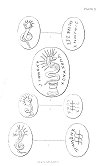
Sacred Texts Gnosticism Index Previous Next
Buy this Book at Amazon.com


The Gnostics and Their Remains, by Charles William King, [1887], at sacred-texts.com

Click to enlarge
Plate D
This class of figures has no connection with Gnosticism considered as a development of Christianity; being nothing more than talismans for the protection of the chest, as I have already shown from Galen. It is true indeed that the Kabbalists of Alexandria sought to heighten the medicinal efficiency of the ancient Pharaonic sigil by adding to it formulæ of their own fashion, embodying the all-powerful Name, but this did not endow the gem with any spiritual sense. The appellation "Kabbalist" I shall always employ in this treatise in its strictest acceptation, and the present is as good a place as any for stating my reasons for doing so. It is the rule nowadays to treat the Kabbala as the pure production of the Middle Ages, and such it probably is, in the form under which it is now presented to us. I will not, indeed, go as far as the most learned Rabbi of our times, and boldly assert that Moses himself was a profound Kabbalist, although "the Wisdom of the Egyptians," in which Holy Writ declares he was a proficient, was beyond a doubt something of very much the same nature. Whatever unprejudiced person will carefully read what I have adduced of the doctrines of Sastri and of Marcus (themselves "converted" Jews) will find there the regular system of the Kabbala fully developed, and its earliest and Egyptian rudiments in the "Pistis Sophia" of Valentinus. No person really acquainted with the history of religions can suppose that these theosophists invented these rules of interpretation: they merely transferred principles sanctioned by antiquity from the explanation of the Old Testament to that of the New.
To return to our Chnuphis, Chubis, or Chuphis (for thus the Greeks transliterated the Coptic Kneph) it is probable that the veneration in which this sigil of the Pharaoh Nechepsi was held, was the true source of the legend concerning Moses's elevation of the Brazen Serpent. At all events, I know of an enamel picture of the scene (date, thirteenth century) in which the Serpent, lifted up on the Cross, is figured with the radiated lion's head, really as he is seen on these talismans. This particular sigil is generally engraved on calcedony, varying in colour from olive-green to waxy-white. The best executed have for material the plasena traversed by an opaque white line (Pliny's Iaspis Graminatias), the estimation of which as an amulet by the Orientals he particularly mentions.
1. The reverse of this gem reads Chumis, accompanied by a row of vowels that appear to contain the word ΙΕΗ, which is, according to Kabbala, an inferior title of God.
2. The Serpent elevated above the thymele, Bacchic altar--a combination betraying the influence of the Dionysiac Mysteries. He declares in phonetic Hebrew, "I, I am the Good Spirit." The reverse of this gem had been covered with a long invocation in minute characters; now almost entirely lost by the fracture of the material in the fire to which it had accompanied its owner. (New York.)
3. This Chnuphis, of exceptionally fine work and yet finer material, has each of the seven rays of the crown tipped by one of the seven vowels that make up the Ineffable Name. The reverse exhibits the serpent-entwined wand, (badge of the Egyptian priesthood) which generally goes with this sigil, and doubtless added to its power. Moses's rod and Aesculapius's club hence took their origin.
4. Another Chnuphis, in the ordinary style. It is noticeable how the gem-cutter has endeavoured to give variety to the endless repetition of the same sigil, by altering the arrangement of the serpentine folds.